There are still a few weeks before head of the Joint List Ayman Odeh begins his first term in Israel’s parliament, yet he has already led a protest across the country. This past weekend Odeh led the “March for Recognition” with hundreds of Bedouins who live in unrecognized villages. The 130 kilometer trek from the southern Negev desert to Jerusalem officially ended on President Reuven Rivlin’s doorstep Sunday afternoon.
Their cause: Bedouins want the government to issue building permits for their towns. They believe this simple piece of paper will unlock access to a treasure trove of state benefits that will radically pull them out of poverty. There was some urgency to the march. Bedouins feel a state program for their forced eviction is creeping into effect. The Prawer Plan, which would forcibly remove 30,000 Bedouins from their towns, was officially tabled by Knesset last year. But Bedouin say it is moving forward anyways, citing demolitions outlined by the plan.
Odeh carried a plan with him in Jerusalem for how Bedouins could gain state benefits — but benefits are not the only demand. As housing laws stand in Israel these villages are slated for demolition because they do not have permits. Odeh’s 300-page blueprint to “recognize” all 46 Bedouin shantytowns with populations totaling 90,000 would save them from this. Moreover, Bedouins are historically shepherds. The plan asks the state to recognize herding towns as a kind of legitimate settlement pattern, which as of now it does not. And so even if the towns were recognized, Bedouins would not be allowed to have animal shelters adjacent to their homes, as is their tradition. Odeh hopes to change that.
Unrecognized Bedouin towns are not marked on any maps. They do not have basic services: water, electricity, sewage—and the residents are denied a slew of other subsidizes including education and healthcare. Their hardships began after Israel was founded in 1948 when Bedouins were rounded up and forced to live inside of a fenced zone, the siyag. During Israel’s first decades of statehood Bedouins, like all Palestinian citizens of Israel, were administered under military code. They were not allowed to leave the siyag. Then in 1966 the state dissolved the military government and Bedouins feasibly could move out of the relocation camp. By that time their original towns had been built over. So they stayed and formed new villages. The state never gave them deeds to these properties and refused to honor their previous land holdings. Without proper permits for houses, Israeli law forbids them from using social services.
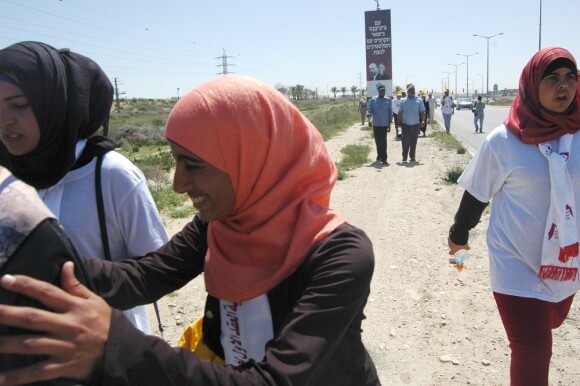
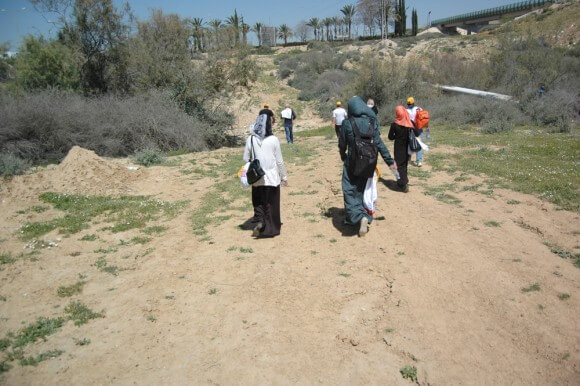
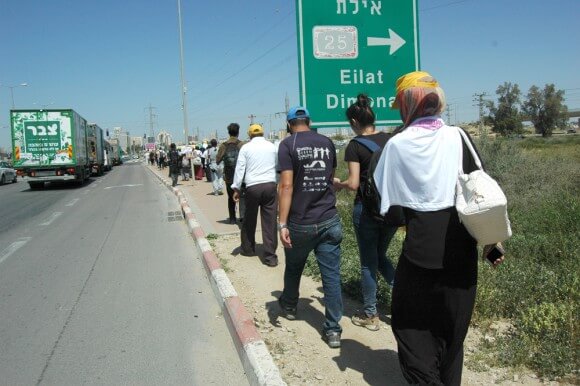
When he reached Jerusalem, Odeh hand delivered the master plan to the president’s wife, Nechama Rivlin. According to the Arab leader’s staff, she warmly received him. They discussed setting up a follow up process with the president directly.
“We are confident in our case, for it’s a just and noble case. It will likely recruit hundreds of thousands of Israelis who believe in the rights of these villages. We are indulging in a popular democratic civilian movement to recognize these villages. I am confident at the end of the journey, the villages will be recognized, and everyone will benefit from this achievement,” said Odeh as he neared the town of Beersheva during the first leg of the walk on Thursday.
Although President Rivlin is in Singapore on ambassadorial duties for a funeral, Bedouins hope he can usher in a break through. As president, Rivlin does not have the power to issue the coveted building permits. But the Bedouins see him as a potential advocate who can command the ears of lawmakers who do have authority over their betterment. And Rivlin who took office last year, has been one of Israel’s most outspoken and unlikely, high-ranking Jewish-Israeli officials to back the plight of Bedouins, and Palestinian citizens of Israel in general.
During election season, the Rivlin visited settlers in Hebron and has spoken openly about the vision of a “greater Israel,” where parts of the West Bank would be annexed into a Jewish state. But he has also underscored the importance of democracy and equal rights. He made two stops to the Bedouin town of Rahat in recent months to cool tensions after two were killed during altercations with the police. Just before Knesset was dissolved ringing in elections, he gave a state apology for an early Israeli massacre of 49 Palestinians in the north of the country in Kfar Kassem. “A terrible crime was committed here, illegal orders topped by a black flag were given here. We must look directly at what happened. It is our duty to teach this difficult incident and to draw lessons,” said Rivlin in late October.
“President Rivlin speaks about equality and justice for all of the citizens of Israel,” said march co-organizer Fadi Masamra, 38, the head of a de facto Bedouin municipality, the Regional Council of Unrecognized villages. “It’s not recognized by the government as an official regional council. It’s an NGO, but it comes out of the community itself because they created it.”
Masamra was born in an unrecognized village, although he now lives in city of Rahat. Rahat was the first Bedouin locality built by Israel in the 1970s, a feeble plan by the state to improve the lives of Bedouins by moving them out of unrecognized towns into a locality with building permits. Yet the city was never fully developed and stands in stark contrast to the manicured desert towns where Jewish-Israelis live nearby.
To date, Rahat lacks water pipes throughout, and central parts of the town do not have paved roads. Most years, Rahat ranks as the most impoverished city in Israel and it is regarded by its residents as a half-ghetto, half-reservation with no opportunities for economic improvement. Masamra’s group wants the state to grant legal status to Bedouin townships, stopping home demolitions because that constant pressure is the driving force behind many families’ decisions to seek housing in Rahat. It was in Masamra’s case. Still, the most destitute among them do not move to Rahat. They stay in the unrecognized villages, living off the grid. When home demolitions occur, they rebuild their houses with tin and tarp, only to be decimated again by the state in a horrific cycle of losing a house over and over again.
“The government is demolishing houses without giving people any other alternative,” said Masamra. Such is the case of al-Arakib, a village that has been bulldozed 82 times, “can you imagine,” exclaimed Masamra. He, Odeh, and dozens more slept the first night of the march in al-Arakib’s cemetery, the only plot of land where Bedouins have managed to keep some semi-permanent structures. The following two nights the protesters camped in wooded areas off of the speedy streets on their protest route.
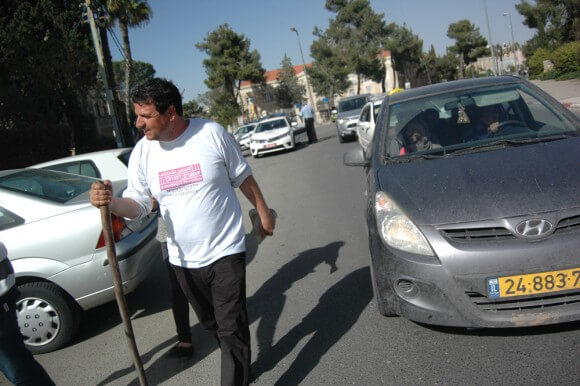
Ultimately, any decision that will alter the precarious status of Bedouins will lay with Odeh’s peers in Knesset. It was the Knesset who in the past ordered government reviews to address longstanding land claims. During the 1970s Bedouins filed petitions with the state to gain lawful ownership of their ancestral territory before the siyag zone. Every few decades another government working-group sought to deal with the issue, each publishing recommendations that were never carried out. While bureaucracy mounted into decades of stalemate on the legal front, the demolitions continued. So much that, bulldozers and re-building have become commonplace in Bedouin pastoral life in the Negev.
Finally last year the Prawer Plan, the brainchild of one of these Knesset caucuses, was put in front of Israel’s parliament. This law would finally end all land claims, though it left little resolution for Bedouins. The program was convoluted, with near impossible guidelines for how the herders could keep their towns. Planners estimated 30,000 of the 90,000 Bedouins in unrecognized villages would be evicted by the state. The United Nations decried it as a plan for “ethnic cleansing,” as it only applied to Bedouins while Jewish-Israelis living in the same region with the same legal status were exempted.
Although Knesset tabled the Prawer Plan, it sent shock waves through Bedouin communities. A series of thousands-strong protests were held across the Negev last year. Bedouins point to it as a source of constant worry. A number of the protesters walking with Odeh wore t-shirts that read “Stop Prawer,” because many say even though it was dropped from Knesset’s agenda, it has already started.

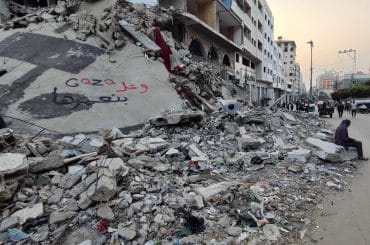

Thank you for this great article.
“He, Odeh, and dozens more slept the first night of the march in al-Arakib’s cemetery, the only plot of land where Bedouins have managed to keep some semi-permanent structures. The following two nights the protesters camped in wooded areas off of the speedy streets on their protest route.”
A beautiful action. It feels genuine. I wish him and the JL the best of luck. I hope that the Prawer Plan is buried soon, never to be retrieved.
Your pictures are fantastic, Allison.
of course it has. they just claimed otherwise to shut up the international community and let everything die down. it’s the israeli way to drag things out for decades .. the slow creeping crawl of ethnic cleansing inside israel vs mowing the grass in gaza vs chunk by chunk in the WB, but essentially it’s the same process over the decades.
i recall first hearing about unrecognized villages when i was in israel w/code pink in 09. we were prevented from entering gaza..i can’t recall the exact incidence but we were trying to set up a swing set somewhere and we were prevented from doing so, turned around on the road and someone in a car had been following us so we pulled over to the side of the road. and a woman, people in the car asked us if we might donate it to their unrecognized village. i asked what that was and that’s when i found out there were over 100 of them, villages the government didn’t recognize and supply utilities to. i was astounded! just completely astounded that this country that called itself modern and supposedly part of western world would solve it’s problems by simply not recognizing a town (100’s of them!) existed. like non people or non citizens or non homes or non anything. it’s really mind boggling.
thanks allison.